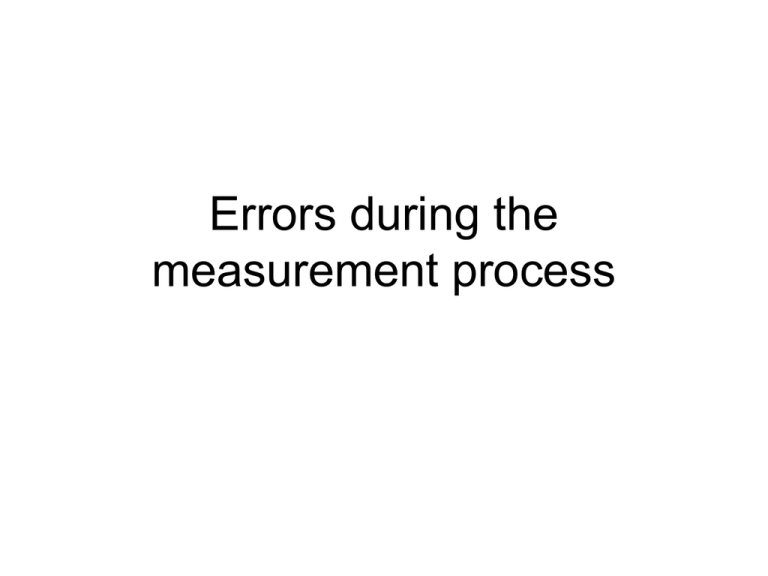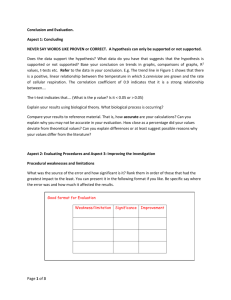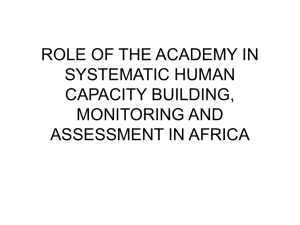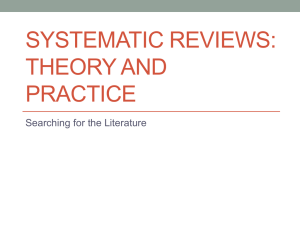Errors during the measurement process
advertisement

Errors during the measurement process Errors in measurement systems • can be divided into – those that arise during the measurement process – those that arise due to later corruption of the measurement signal by induced noise during transfer of the signal from the point of measurement to some other point • It is extremely important in any measurement system to reduce errors to the minimum possible level and then to quantify the maximum remaining error that may exist in any instrument output reading • However, in many cases, there is a further complication • that the final output from a measurement system is calculated by combining together • two or more measurements of separate physical variables Errors arising during the measurement process • can be divided into two groups – systematic errors – random errors Systematic errors • Systematic errors describe errors in the output readings of a measurement system that are consistently on one side of the correct reading, i.e. either all the errors are positive or they are all negative • Two major sources of systematic errors – system disturbance during measurement – the effect of environmental changes (modifying inputs) • Other sources of systematic error include bent meter needles, the use of uncalibrated instruments, drift in instrument characteristics and poor cabling practices Random errors • Random errors are perturbations of the measurement either side of the true value caused by random and unpredictable effects, such that positive errors and negative errors occur in approximately equal numbers for a series of measurements made of the same quantity • Such perturbations are mainly small, but large perturbations occur from time to time, again unpredictably. • Electrical noise can also be a source of random errors • To a large extent, random errors can be overcome by taking the same • measurement a number of times and extracting a value by averaging or other statistical techniques Sources of systematic error • System disturbance due to measurement – Disturbance of the measured system by the act of measurement is a common source of systematic error System disturbance due to measurement Example cases • If we were to start with a beaker of hot water and wished to measure its temperature with a mercury-in-glass thermometer, then we would take the thermometer, which would initially be at room temperature, and plunge it into the water. • In so doing, we would be introducing a relatively cold mass (the thermometer) into the hot water and a heat transfer would take place between the water and the thermometer. This heat transfer would lower the temperature of the water. Whilst the reduction in temperature in this case would be so small as to be undetectable by the limited measurement resolution of such a thermometer, the effect is finite and clearly establishes the principle that, in nearly all measurement situations, the process of measurement disturbs the system and alters the values of the physical quantities being measured System disturbance due to measurement • analysing system disturbance during measurements in electric circuits Example Example Exercise 1 • The voltage across a resistance R5 in the circuit is to be measured by a voltmeter connected across it. (a) If the voltmeter has an internal resistance (Rm) of 4750, what is the measurement error? (5%) (b) What value would the voltmeter internal resistance need to be in order to reduce the measurement error to 1%? (24.750 ohm) Exercise 2 • In the circuit shown below, the current flowing between A and B is measured by an ammeter whose internal resistance is 100 . What is the measurement error caused by the resistance of the measuring instrument? Errors due to environmental inputs • An environmental input is defined as an apparently real input to a measurement system that is actually caused by a change in the environmental conditions surrounding the measurement system. Example Cases • Suppose we are given a small closed box and told that it may contain either a mouse or a rat. We are also told that the box weighs 0.1kg when empty. If we put the box onto bathroom scales and observe a reading of 1.0 kg, this does not immediately tell us what is in the box because the reading may be due to one of three things: – a 0.9 kg rat in the box (real input) – an empty box with a 0.9 kg bias on the scales due to a temperature change (environmental input) – a 0.4 kg mouse in the box together with a 0.5 kg bias (real + environmental inputs). • Thus, the magnitude of any environmental input must be measured before the value of the measured quantity (the real input) can be determined from the output reading of an instrument.











